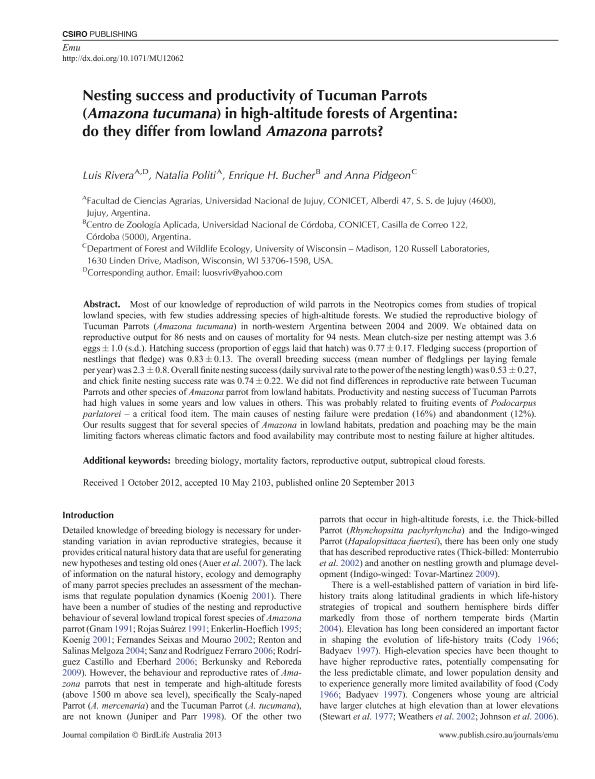Mostrar el registro sencillo del ítem
dc.contributor.author
Rivera, Luis Osvaldo

dc.contributor.author
Politi, Natalia

dc.contributor.author
Bucher, Enrique Hugo

dc.contributor.author
Pidgeon, Anna
dc.date.available
2015-07-20T21:29:01Z
dc.date.issued
2013-09
dc.identifier.citation
Rivera, Luis Osvaldo; Politi, Natalia; Bucher, Enrique Hugo; Pidgeon, Anna; Nesting success and productivity of Tucuman Parrots; Csiro Publishing; Emu; 114; 1; 9-2013; 41-49
dc.identifier.issn
0158-4197
dc.identifier.uri
http://hdl.handle.net/11336/1289
dc.description.abstract
Most of our knowledge of reproduction of wild parrots in the Neotropics comes from studies of tropical lowland species, with few studies addressing species of high-altitude forests. We studied the reproductive biology of Tucuman Parrots (Amazona tucumana) in north-western Argentina between 2004 and 2009. We obtained data on reproductive output for 86 nests and on causes of mortality for 94 nests. Mean clutch-size per nesting attempt was 3.6 eggs±1.0 (s.d.). Hatching success (proportion of eggs laid that hatch) was 0.77±0.17. Fledging success (proportion of nestlings that fledge) was 0.83±0.13. The overall breeding success (mean number of fledglings per laying female per year) was 2.3±0.8. Overall finite nesting success (daily survival rate to the power of the nesting length) was 0.53±0.27, and chick finite nesting success rate was 0.74±0.22. We did not find differences in reproductive rate between Tucuman Parrots and other species of Amazona parrot from lowland habitats. Productivity and nesting success of Tucuman Parrots had high values in some years and low values in others. This was probably related to fruiting events of Podocarpus parlatorei - a critical food item. The main causes of nesting failure were predation (16%) and abandonment (12%). Our results suggest that for several species of Amazona in lowland habitats, predation and poaching may be the main limiting factors whereas climatic factors and food availability may contribute most to nesting failure at higher altitudes.
dc.format
application/pdf
dc.language.iso
eng
dc.publisher
Csiro Publishing

dc.rights
info:eu-repo/semantics/openAccess
dc.rights.uri
https://creativecommons.org/licenses/by-nc-sa/2.5/ar/
dc.subject
BREEDING BIOLOGY
dc.subject
MORTALITY FACTORS
dc.subject
REPRODUCTIVE OUTPUT
dc.subject
SUBTROPICAL CLOUD FORESTS
dc.subject.classification
Ecología

dc.subject.classification
Ciencias Biológicas

dc.subject.classification
CIENCIAS NATURALES Y EXACTAS

dc.title
Nesting success and productivity of Tucuman Parrots
dc.type
info:eu-repo/semantics/article
dc.type
info:ar-repo/semantics/artículo
dc.type
info:eu-repo/semantics/publishedVersion
dc.date.updated
2016-03-30 10:35:44.97925-03
dc.journal.volume
114
dc.journal.number
1
dc.journal.pagination
41-49
dc.journal.pais
Australia

dc.journal.ciudad
Collingwood
dc.description.fil
Fil: Rivera, Luis Osvaldo. Universidad Nacional de Jujuy. Facultad de Ciencias Agrarias; Argentina. Consejo Nacional de Investigaciones Científicas y Técnicas; Argentina
dc.description.fil
Fil: Politi, Natalia. Universidad Nacional de Jujuy. Facultad de Ciencias Agrarias; Argentina. Consejo Nacional de Investigaciones Científicas y Técnicas; Argentina
dc.description.fil
Fil: Bucher, Enrique Hugo. Consejo Nacional de Investigaciones Cientificas y Técnicas. Centro Cientifico Tecnol. CONICET - CÓrdoba. Instituto de Diversidad y Ecologia Animal; Argentina
dc.description.fil
Fil: Pidgeon, Anna. University of Wisconsin; Estados Unidos
dc.journal.title
Emu

dc.relation.alternativeid
info:eu-repo/semantics/altIdentifier/doi/http://dx.doi.org/10.1071/MU12062
Archivos asociados
